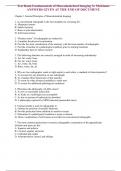Test Bank Fundamentals of Musculoskeletal Imaging 5e McKinnis
ANSWERS GIVEN AT THE END OF DOCUMENT.
Chapter 1 General Principles of Musculoskeletal Imaging
1. A conventional radiograph is the best modality for screening for:
A. Metastatic tumors
B. Subtle fractures
C. Bone or joint abnormality
D. Soft tissue lesions
2. “Routine series” of radiographs are ordered to:
A. Complete the physical examination
B. Provide the most visualization of the anatomy with the least number of radiographs
C. Provide a baseline of a pathological condition prior to starting treatment
D. Standardize data for future research
3. The following densities are correctly arranged in order of increasing radiodensity:
A. Air, fat, water, bone
B. Fat, air, water, bone.
C. Air, water, fat, bone
D. Bone, water, fat, air
4. Why are two radiographs, made at right angles to each other, a standard of clinical practice?
A. To account for any distortion on one radiograph
B. To visualize three dimensions of the anatomy
C. To scout for what advanced modality to order next
D. To screen for additional pathological conditions
5. What does the philosophy ALARA mean?
A. As low as reasonably achievable
B. As lucky as a radiologist can accomplish
C. As low an amount of radioactivity absorbed
D. A philosophy replaced by MPD (maximal permissible dose)
6. Contrast media is used in radiography to:
A. Outline the position of metallic hardware
B. Provide protection from radiation to sensitive tissues
C. Determine if a pathological condition is acute or chronic
D. Allow visualization of soft tissues not evident on conventional radiographs
7. The most common projections in routine radiographic examination of the appendicular
skeleton and spine are the:
A. Superior and inferior
B. Coronal, sagittal, and axial
C. Cephalad and caudal
D. Anteroposterior, lateral, and oblique
,8. Accepted convention for viewing radiographs is to look at the image as if the patient were
facing the viewer.
A. True
B. False
9. Radiographic distortion is the difference between the actual object and its recorded image.
Every radiograph will have a degree of size or shape distortion.
A. True
B. False
10. A major advantage of the bone scan is how sensitive it is to increased bone metabolism. A
major disadvantage of the bone scan is:
A. Lack of specificity to the pathological condition
B. It can only show cortical bone, not cancellous bone
C. It is unable to visualize the entire skeleton in one exam
D. It can show only structural, not physiological, changes
,Chapter 2 Radiologic Evaluation, Search Patterns, and Diagnosis
1. A search pattern for viewing radiographs is the ABCs, which stands for:
A. Alignment, bone density, cartilage spaces, soft tissues
B. Anatomy, body mass, connective tissues
C. Alignment, breaks in continuity, cortical margins, soft tissues
D. None of the above
2. Predictor variables help narrow the diagnostic possibilities. If a lesion is wider than it is long
and has poorly defined margins, these characteristics are predictive of what kind of lesion?
A. Malignant
B. Metastatic
C. Benign
D. Infectious
3. Sclerosis is seen on radiograph as _______________ and is a sign of ____________.
A. radiolucent; repair.
B. radiolucent; inflammatory process
C. radiodense; repair
D. radiopaque; repair
4. Radiologic hallmarks of degenerative joint disease include:
A. Concentric joint space narrowing, sclerotic subchondral bone, and periarticular
rarefaction
B. Asymmetrical joint space narrowing, sclerotic subchondral bone, and pseudocysts
C. Osteophyte formation and osteoporosis
D. Asymmetrical joint space narrowing and articular erosions
5. Radiologic hallmarks of rheumatoid arthritis include:
A. Concentric joint space narrowing, erosions of subchondral bone, and periarticular
rarefaction
B. Asymmetrical joint space narrowing, sclerotic subchondral bone, and pseudocysts
C. Osteophyte formation and osteoporosis
D. Asymmetrical joint space narrowing and articular erosions
6. Joint capsules become visible on radiograph when they become distended by effusion seen in
the instance(s) of:
A. Acute infection
B. Hemophilic bleed
C. Joint trauma
D. All of the above
7. If an abnormality discovered on radiograph has characteristics of a malignant lesion, the next
step is diagnostic evaluation is:
A. Advanced imaging
B. Surgery
, C. Chemotherapy
D. Radiation
8. Osteoporosis is a metabolic disease that results in decreased total bone mass. What percent of
reduction in bone mass must occur before osteoporosis becomes evident on radiographs?
A. 20%
B. 30%
C. 40%
D. 50%
9. Tumors are generally divided into two categories, based on the amount of bony destruction
they incur:
A, Benign and malignant
B. Benign and metastatic
C. Primary and secondary
D. Aggressive and benign
10. What procedure is necessary to accurately define the infectious organism in an infected joint?
A. MRI with contrast
B. Nuclear imaging with a glucose analog
C. Aspiration biopsy
D. Bone scan




